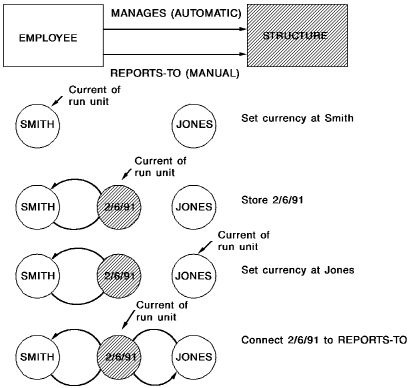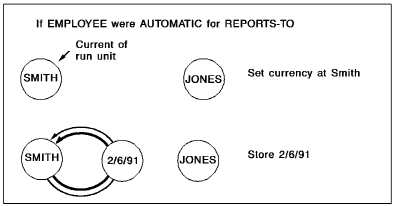

Membership options determine how an entity is connected to and disconnected from a relationship. These options affect the use of the DML STORE, CONNECT, DISCONNECT, and ERASE statements.
You define membership options in two parts. The first part indicates the manner (mandatory or optional) in which the entity is disconnected from a linked relationship. The second part indicates the manner (automatic or manual) in which the entity is connected to a linked relationship.
Disconnect options
The disconnect options operate as follows:
The mandatory/optional membership specification affects the outcome of the DML ERASE statement. If any of the ERASE options (PERMANENT, SELECTIVE, ALL) is specified when an ERASE statement is issued against an entity, all mandatory entities owned by that entity are also erased. Optional child entity occurrences are left as is, disconnected, or erased, depending on the ERASE option specified.
Mandatory disconnect
The disconnect option is usually specified as mandatory. However, do not specify the mandatory disconnect option when:
Important! Be careful when using the optional disconnect option for child entities of a relationship stored clustered around that relationship. If the entity is later disconnected from its original parent and connected to another, CA IDMS/DB does not physically relocate the entity; for all practical purposes, that entity is no longer clustered around its parent.
Connect options
The connect options operate as follows:
Disconnect and connect options are combined to form membership options:
Automatic connect
The connect option is usually specified as automatic. However, do not specify the automatic connect option when:


Guidelines
The manual connect and optional disconnect options permit greater flexibility but require more programming effort. Additionally, they provide less control over data integrity. You should therefore choose the mandatory automatic (MA) membership option, unless there exists a special business requirement for optional disconnect and/or manual connect functions.
Representing membership options
Represent membership options for a relationship on the data structure diagram by specifying the membership options to be used: MA, MM, OA, or OM.

|
Copyright © 2014 CA.
All rights reserved.
|
|